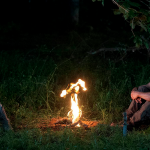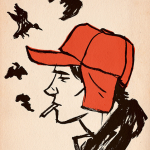“God tames us, drawing us into an embrace that asserts at once our uniqueness and our place in a grand cosmic scheme.”
“Tell me about God,” my daughter says as she wraps her arms around my neck.
“Tell me about how you and daddy asked for me and then for baby sister.”
This liturgy has become our twilight ritual. A prayer and the “Moon Song,” and the request to “Snuggle me ALL NIGHT LONG!” So I settle in, wrapping her in my arms and her hungry caterpillar quilt, knowing I will head downstairs again all too soon, and long before sunrise.
I begin the story, how my husband and I got married and prayed for a baby girl and then loved her oh so much that we prayed for another baby girl and how we are so thankful for our daughters, our gifts from God. My daughter knows the order, the words, and holds me to them, setting a rhythm for this ceremony that establishes her and her sister as chosen. It’s a story of origin, of her life and our family. It gives us a history, a continuum, a larger narrative to participate in while still establishing each one of us as individuals. I think, in my parental musings on this bedtime routine, it makes her feel loved.
If you asked me to describe either of my daughters, I could do so in a number of ways. I could tell you their heights and weights, their respective eye colors. I could tell you that my older daughter will before long grow tired of hearing how much she looks and acts like me. I could give you a snapshot. Not one of those examples would capture the way that my elder child plays “sad pony” when she needs our attention to cheer her up, or the way she makes all of us laugh with her “Big Bad Wolf” expression, or the way she says, “Come ‘ere, you,” as she pulls me into an embrace. It’s the stories that make things meaningful, that capture the fleeting feelings of a moment and give them a history, a purpose both particular and timeless.
That’s the kind of love that Antoine de Saint-Exupéry calls “taming” in The Little Prince. When the title character meets a fox, the animal explains:
My life is monotonous. I hunt chickens and men hunt me. All chickens are alike and all men are alike. So I get a little bored. But if you tame me, my life will be full of sunshine. I shall recognise the sound of a step different from all others. The other steps send my hurrying underground. Yours will call me out of my burrow like the sound of music. And look yonder! Do you see the cornfields? I do not eat bread. Wheat is of no use to me. Those cornfields don’t remind me of anything. And I find that rather sad! But you have hair the colour of gold. So it will be marvelous when you have tamed me! Wheat, which is also golden, will remind me of you. And I shall love the sound of the wind in the wheat. (78)
Being “tamed” is being loved, being known intimately and loved unconditionally because of—or in spite of—that knowledge. It’s the depth of relationship that imbues every other aspect of life with meaning and purpose. It’s the kind of love that God gives His creation—knowing every star in the sky and every sparrow that falls and every hair on our heads; from the heavens to the earth to a single hair on our scalps, God tames us, drawing us into an embrace that asserts at once our uniqueness and our place in a grand cosmic scheme. To be loved, truly, is to be known in a story.
That, for me, is the lingering message of Carol Rifka Brunt’s debut novel Tell the Wolves I’m Home. I am haunted by this novel. Brunt’s story centers around 14-year-old June, who loses her beloved Uncle Finn to AIDS, and after his death, discovers Toby, the partner whom Finn had hidden away from the family at the demand of June’s mother. It is a story of jealousy: June’s mother scheming to keep both June and Toby from superseding her place in her baby brother’s life; June’s sister Greta tormenting her for preferring Finn; June struggling with the discovery of Toby and the realization of Finn’s private world in which she was never included. It is a story of opportunities lost, intimacies and relationships sacrificed because of petty jealousies that could not conceive of a love that multiplies rather than divides. As the story of Toby unravels after Finn’s death, June learns of all the secrets that kept them apart:
Finn hid his secret boyfriend in the basement? I might have felt sorry for Toby if the place wasn’t so beautiful. If it wasn’t so completely obvious that a person would only make someplace like this for someone they really loved. I thought of all the times I’d been upstairs in the apartment, and now those memories were getting mixed up with the picture of Toby skulking around down here. Right underneath me all the time. . . . Then I realized that this was my mother’s fault. There wouldn’t be any underground annex if it wasn’t for her. I would have known Finn and Toby together all along. And then what? I guess I never would have been so close to Finn. I never would have thought that I might be the most important person he had. (177)
June sneaks off to meet with Toby, whom her family excluded even from Finn’s funeral, and finds out more and more of their story. She is displaced by secrets, marginalized from a self-constructed narrative that had put her at the center of Finn’s existence, as he was at the center of hers.
Yet Toby is equally displaced, hidden away from June and her family, relegated to hiding in the basement and falsely blamed for infecting Finn with AIDS. Both June and Toby reach out to each other (June reluctantly) in response to post-mortem notes from Finn asking them to look after each other. It is Finn who knows them both, Finn who loves them both, Finn who ultimately brings together two people desperately in need of belonging; the friendship between June and Toby is redemptive, but it springs forth from a well of secrets and scorns, a shuffling and shoving to gain the center of Finn’s story even after he is dead.
In one painful moment, June is forced to accept that both Toby and Finn knew the scope of June’s love for her uncle. “June, it’s all right. We know how you felt,” Toby says. And June responds in silence, thinking, “Finn knew. Finn knew and Toby knew. They both knew. Of course Finn would know. He always knew my heart. . . . I wanted to erase every wrong cell of my body.” But June is trapped, stuck on the train next to Toby, who tries to comfort her with the words: “You think I don’t know about wrong love, June? You think I don’t understand embarrassing love?” (280) Toby disorients June, disrupting her sense of specialness with the uncle who always knew her heart, but in doing so, Toby offers her a bigger story to ponder—a sense of Finn as a whole person outside of her knowledge of him, a sense of Toby’s loss and isolation, a sense that, ultimately, drawing closer to Toby can actually bring them both closer to Finn. Their stories, shared, enhance the picture of her uncle’s life.
By the novel’s conclusion, June realizes, “Toby was right. Finn was my first love. But Toby, he was my second. And the sadness in that stretched like a thin cold river down the length of my whole life” (347). Toby’s story is marked by loss, by sacrifice; in coming to know Toby, June’s life is marked by those traits too. She comes to embrace Toby as Toby, not for what he can give her of Finn but for who he is. It’s easy to confuse love for a feeling, yet Toby and June remind me how much love is active, a verb; 1 Corinthians 13 describes all that love is and is not, yet in that passage so often recited at weddings, it’s easy to lose sight of the last part, verse 12: “For now we see only a reflection as in a mirror; then we shall see face to face. Now I know in part; then I shall know fully, even as I am fully known.” By loving each other, Toby and June love those around them, including Finn, more deeply. Their shared stories ultimately do not detract from the love either felt for him, but reveal his specialness more and incorporate both of them into a bigger picture. The fox’s love for The Little Prince changes the entire landscape, just as my daughter’s liturgy invokes a powerful story of love that moves through our family. But beyond the reach of all those stories is the one story that longs to draw us all into embrace—the story of an intimacy, a knowledge, a love so deep that it never fails.
Illustration courtesy of Seth T. Hahne. Check out his graphic novel and comic review site, Good Ok Bad.











